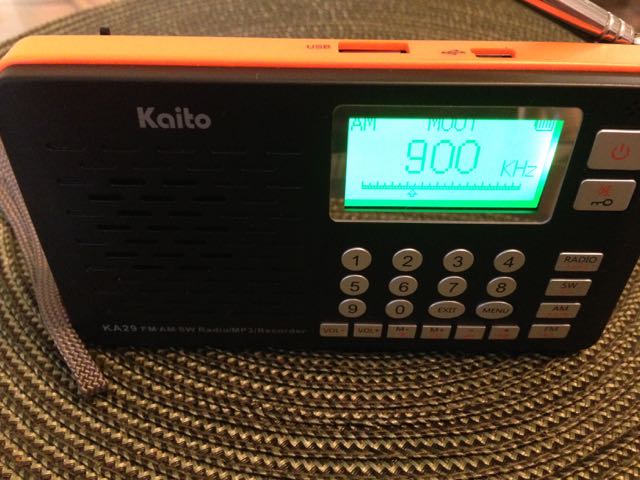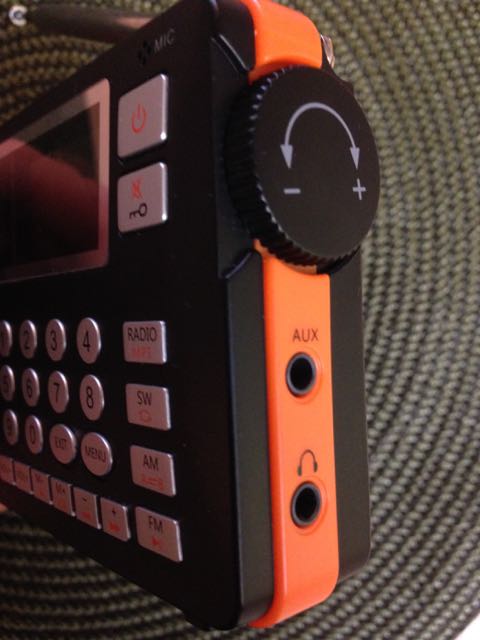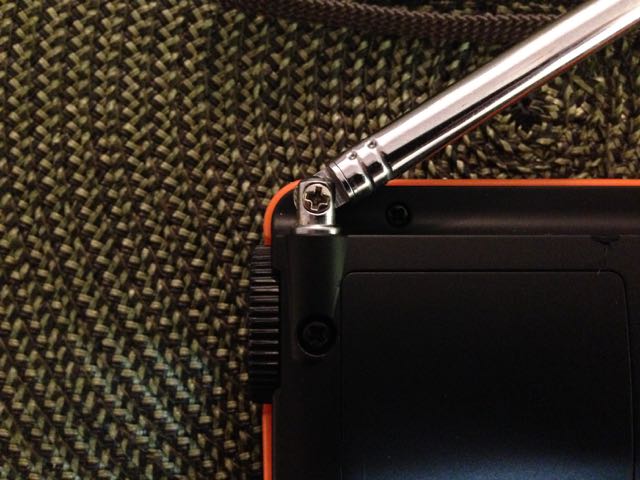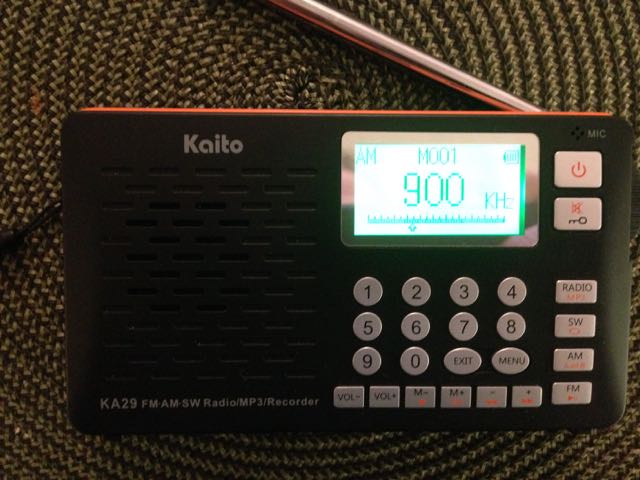While doing a somewhat random search on Amazon a few weeks ago, I stumbled upon a radio with a model number that I didn’t recognize–the Kaito KA29.
The form factor of the KA29 is very reminiscent of the Degen DE1129 I reviewed two years ago, but it’s smaller and sports a number pad on the front. On a whim, and with possible use of this radio in my charitable work at ETOW, I purchased one. At ETOW we have used similar radios with 16-32 GB Micro SD cards, chock-full of educational audio content. At $35, the KA29 is an affordable MP3 player and radio.
On a side note, I suppose I should mention that I was pretty disappointed with the DE1129 because I had hopes it would make for a great all-in-one portable radio recorder for ETOW. While the DE1129 could record FM/AM and SW radio directly, it had serious problems: it auto-adjusted the volume level during recording (one could not turn off the internal speaker), it degraded audio quality in recording, and medium wave was plagued with a “ticking” sound every 10 seconds. It produced digital hash on various meter bands. My summary of the DE1129: fine concept, poor engineering. Read my full review of the first version of the DE1129 here.
The Kaito KA29: First impressions
The Kaito KA29 is a cute little portable. Mine has a black body with orange band encircling the diameter. That orange band is actually a nice addition–it helps the radio show up a bit better and makes the ports a little easier to see when lighting is low.
The overall quality of the radio feels fine: the hard plastic body has a smooth matte quality and the buttons have a very tactile response. The telescopic whip antenna is long for the overall radio size, but is still a little on the short side for good HF gain. Oddly, unlike most radios, the antenna cannot swivel at its point of attachment to the chassis; it can only be extended and tipped side-to-side–but not front to back, or back to front. Like the DE1129, the KA29 lacks a back stand–a big negative in my book–but admittedly a back stand would be of little use while SWLing with this rig because the antenna can’t be swiveled or tipped into a useful vertical position. Hm. Also like the DE1129, the KA29 uses a slim rechargeable battery pack.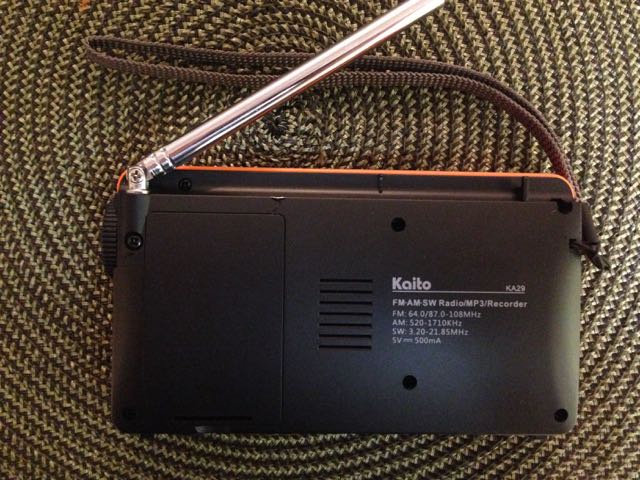
When I first turned on the KA29, I thought I had received a faulty unit: I pressed and held the power button for a second, the display lit up a bright green, I released the power button…and the unit turned off. After a little trouble-shooting, I realized that the KA29 requires holding the power button a full two seconds, until the “Kaito” brand name appears on the display.
This sluggish power-up response is truly an indicator of most functions on the KA29. It’s as if every function is controlled by a slow processor–which I’ve no doubt is the case.
As far as I can tell, all the menu functions are the same on the Degen DE1129; obviously, they’re built on the same firmware. Indeed, Kaito is the North American brand for the Chinese manufacturer, Degen; the Degen model number for this radio is DE29. In this sense, most functions are familiar to me.
Tuning
The one added feature of the KA29 that my version of the DE1129 didn’t have is a number pad, useful for direct entry of radio frequencies. I should note here that I (typically) toss the owner’s manual aside when I first get a radio, in order to test how intuitive its functions are. I spent quality time with the KA29 while traveling a few weeks ago, and as I didn’t bring the manual, I had to learn its functions via trial and error. It wasn’t until I returned that I learned how to use direct frequency entry; the is answer clearly stated in the manual: just key in the frequency, then press the appropriate band (AM/FM/SW) to go to that frequency. Pretty simple, actually. The response time for the radio to start playing the frequency you enter is only about one second.
Use of the tuning knob (located on the right side of the radio) is easy and straightforward–tuning up and down will move the needle 5 kHz steps between frequencies. Unfortunately, as on the DE1129, 5 kHz is the smallest tuning step available. The KA29 briefly mutes between frequency changes, so when tuning slowly it’s very noticeable. If you tune quickly, the KA29 will produce snippets of audio as you pass signals, but I find it often skips over even very strong signals. In short? Though I suppose it could be worse, I do not like tuning the KA29.
I should also mention that the KA29 has no adjustable bandwidth; I’m guessing the AM bandwidth is stuck at around 6 or 7 kHz.
Performance
While I no longer have the DE1129 in hand for side-by-side comparison, my impression is that performance between the two radios is very similar.
Audio fidelity
Herein lies the strength of the KA29. It obviously uses the same speaker technology (with an acoustic chamber) that the DE1129 uses. You will be favorably impressed with the audio from this wee radio–it is quite robust for a pocket radio of this size, and in a small room, almost room-filling. It sounds fantastic on FM and AM alike–you can even hear a hint of bass. One day, I tuned the KA29 to a local AM station and listened quite comfortably in another room. Impressive.
But what about receiver performance?
FM
FM performance is quite good. I’ve used the KA29 in two different cities, and found that it could detect most of the same FM stations my other portables picked up.
AM/Medium Wave
I was pleasantly surprised to note the absence of the annoying ticking sound I heard in the DE1129; it appears Degen engineers have succeeded in eliminating this distraction. In general, I believe the KA29 performs acceptably on medium wave for basic local and nighttime clear channel broadcast listening. The AGC circuit is not ideal, though, for any sort of medium wave DXing; don’t consider the KA29 for MW DX.
Shortwave
If the KA29 is better than the DE1129 on the shortwave bands, the improvement is negligible. You’ll be fairly happy with the KA29 while listening to strong shortwave broadcasts. During my review, I listened to the new Global 24 a few hours on 9,395 kHz–an easy catch on the east coast of North America–and the KA29 was fairly stable, producing rich audio.
Here are the cons on shortwave:
Automatic Gain Control
While listening to weak stations, you’ll discover the KA29 to be somewhat sensitive, but again, the AGC circuit is just too active to listen comfortably for very long.
Noise floor
The noise floor is more obvious while listening to weak signals: I believe much of the noise is coming from the internal electronics of the KA29. It produces an audible digital hash sound that makes weak-signal listening a bit of a chore.
Images
Quite often as I tuned around the shortwave bands, I noticed that FM stations bleed through the audio. Check out this audio sample as I attempted to listen to Radio Ryhad:
Indeed, even if the shortwave station has a relatively strong signal (like this recording of Global 24) you can often hear noise:
For comparison, listen to the other radios I recorded at the same time for the ultra portable shoot-out.
Onboard Recording
Fortunately, several of the recording problems I noted with the DE1129 are no longer an issue with the KA29.
Fixed volume
The DE1129, when recording radio, had the exceedingly annoying habit of automatically setting the internal speaker’s volume to a high level. While recording, this could not be changed.
Fortunately, this problem has mostly been addressed in the KA29, which does not increase the volume while making a recording, but still fixes the volume at the level set at the recording’s start. I didn’t find this to be much of a problem.
Audio quality
The recording performance is better than that of the DE1129, which produced noisy, muffled recordings. The KA29 will produce fair audio recordings on AM, on FM, and on shortwave. One drawback: you will note a low-volume, high-pitched static noise–a hiss, to be specific–inherent in every radio recording, regardless of band. While it’s not too offensive, nor enough to deter me from making direct radio recordings (at least of strong stations), there is still much room for improvement. Obviously, I can use the headphone jack and an external digital recorder to make better radio recordings. But the convenience of an all-in-one recording device plus radio outweighs the slight hiss in the internal recordings it produces.
All in all? I’m reasonably pleased with the radio recording capabilities of the KA29, and the improvements it’s made over its predecessor. If the Degen engineers could lower the KA29’s noise floor and fix the imaging problems, and add 1 kHz tuning increments, this could be a good value all-in-one radio, a real contender.
Summary
Ever radio has its pros and cons. The following is a list I made while reviewing the KA29:
Pros:
- Keypad entry
- Great audio for a tiny radio
- FM reception quite good
- MP3 playback audio is good
- Onboard radio recording acceptable (see con)
- 9/10 kHz select-able medium wave steps
Cons:
- Sluggish response to most actions; if (for example) volume control has been used, you must wait nearly 4 seconds before using another function
- Awkward menu to navigate
- No bandwidth selections
- Imaging on SW bands
- Fixed 5 kHz steps on shortwave
- No adjustable bandwidth
- Digital noise on portions of MW and SW bands
- Low audio hiss present in all internal radio recordings (see pro)
- No back stand
- Antenna does not swivel 360 degrees for optimal placement
Conclusion?
If you’re looking for a pocket radio to make local radio recordings on-the-go, and the quality of your recordings is not a major concern, you might give the KA29 a try; chances are you’ll be fairly pleased with the affordable KA29.
If you’re a shortwave radio hobbyist or DXer of any stripe, however, don’t waste your time or money on the DE1129. Instead, pitch in $10 more and buy a Tecsun PL-310ET–it has no MP3 recording or playback, but it will receive circles around the KA29.


